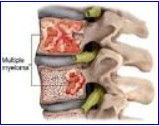

“Multiple myeloma"-bone pain caused by cancer
Case Sharing
92-year-old Mr. Chen developed pain in his ribs and chest in March this year, and his upper back was sore and weak. He feels pain in his ribs and upper back in the middle of the night especially when he gets up at night to go to the bathroom. Mr. Chen was unable to move his body, and he also had difficulty breathing.
However, the condition seemed to ease a little in the morning. After seeing a doctor, he felt a little better after taking the painkiller, but once he stopped taking it, the pain reappeared.
When I saw Mr. Chen for the first time, he was in good spirits except for his ribs, chest and back pain. Because he has been smoking for decades, he took X-rays of his chest, lungs and ribs. There are no finding such as fractures or tumors from the X-rays. It is just an old age bone degeneration.
The treatment is mainly to relieve pain, using ultrasound, electrode stimulation, soft laser method and manual therapy adjusting the ribs and thoracic vertebrae. At first, it relieved the condition, but after 3 weeks of treatment, the condition was ups and down. Later, after further investigation, it was revealed that Mr. Chen was suffering from stage III multiple myeloma.
Case Analysis
Multiple myeloma is an incurable hematological tumor. It is mainly caused by abnormal proliferation of plasma cells in the bone marrow that produce immunoglobulins, leading to cancer. This disease mostly occurs in middle-aged to elderly people (over 60 years old). Because the symptoms are not obvious, nor can clinical symptoms occur in a short period of time, the disease usually occurs slowly and gradually, and most patients are found to be sick when they seek medical attention because of back pain or fractures.
Cause
Mature plasma cells in the bone marrow secrete antibodies to enhance their ability to fight foreign viruses and bacteria. However, when plasma cells develop cancerous lesions, they will replicate and produce a large number of malignant plasma cells, called myeloma cells.
Bone marrow cancer cells accumulate in the bone marrow or on the outside of the bone and will gradually erode the bone; forming cancerous masses, causing multiple tumors. When malignant myeloma occurs, the hard bones of the bones are destroyed, causing bone pain.

Symptoms and Complications
There are no obvious symptoms in the early stage. Usually when a large number of bone marrow cancer cells accumulate, the bones erodes and a large number of abnormal antibody proteins (peraprotein) are produced causing a series of symptoms. Mainly divided into four major symptoms, also known as CRAB = Hypercalcium (high blood calcium) , R=Renal failure (renal failure), A=Anemia (anemia), B=Bone Lesions (skeletal disease).
I would like to discuss more about the effects of this cancer on bone pain and bone dysfunction. When the number of bone marrow cancer cells concentrated on the bones increases, the number of bone eroding cells grows more and more, and many bones in the body will be slowly destroyed by erosion. Insufficient bone support strength can cause bone pain when the condition is severe, and can cause osteoporosis, pathological fractures, hypercalcemia, etc. Bone pain can make it difficult for the patient to walk, spinal pain, rib pain and thoracic pain are more serious and common.
If the patient’s neurological symptoms are caused by the bone marrow compressing the spinal nerves, it will cause progressive bone pain, numbness, weakness of the calves, hemiplegia, or inability to control the bowel and urine, etc., which causes the problem to gradually appear.
Diagnose
Multiple myeloma is not easy to diagnose in the early asymptomatic period. Blood tests are usually arranged when the patient has suspected symptoms (CRAB symptoms). If there are abnormal data in the blood test report, further examinations such as biochemical examination, serum protein electrophoresis, urine examination, bone marrow extraction, X-ray, biopsy, immunoassay and chromosome examination will be performed.
Treatment of multiple bone marrow
Treatment is mainly to control and suppress the disease, including chemotherapy and radiotherapy, but it depends on the age and condition of the patient. In addition, supportive therapies such as taking analgesics, steroids, and bisphosphonates can be used to control hypercalcemia. For anemia, blood transfusion and injection of erythropoietin can be used.
Postscript: Due to Mr. Chen’s old age and because his family did not want the patient to face various side effects after receiving treatment. Mr. Chen Lao finally left peacefully later due to complications of pneumonia caused by multiple myeloma.

 Book an Appointment
Book an Appointment


